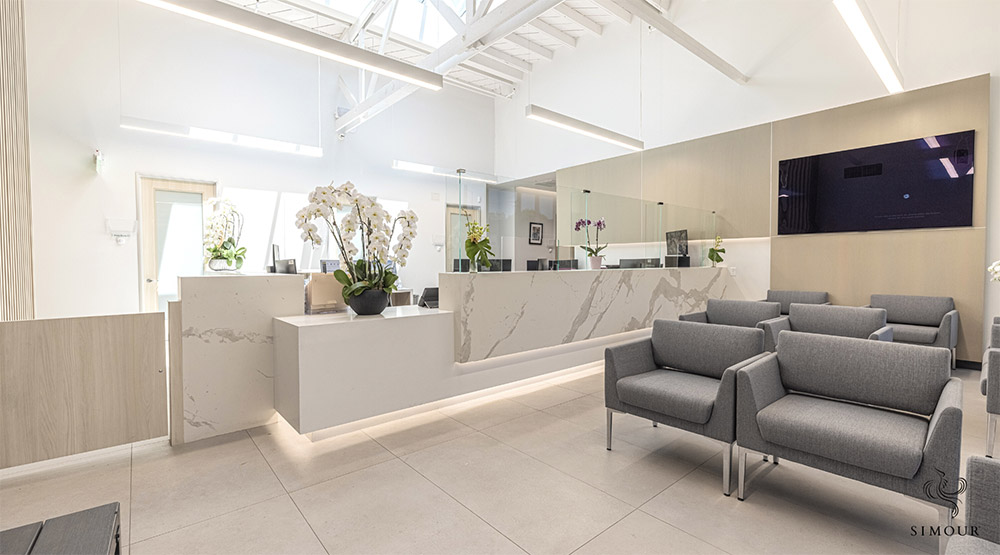“Design is not just what it looks like and feels like. Design is how it works.” – Steve Jobs
While many factors contribute to a healthcare facility’s profitability, property developers and facility managers are taking notice of the significant role that interior design plays in optimizing financial outcomes to maximize return on investment (ROI) in healthcare spaces. In this blog, we will explore how strategic medical interior design can revolutionize healthcare quality, profitability, and long-term success.
1. Brand Identity and Market Positioning
Interior design plays a pivotal role in establishing a strong brand identity and market positioning for healthcare facilities. The design elements, color schemes, and material choices can reflect the organization’s values, mission, and unique selling proposition. A consistent and well-executed interior design strategy can differentiate healthcare facilities from competitors, reinforcing a positive brand image in the minds of patients and stakeholders. By incorporating elements such as color schemes, artwork, and furniture that align with the brand’s values and mission, interior designers help create a unique and memorable experience for patients and visitors. A well-designed space that reflects the facility’s brand identity not only fosters patient loyalty but also differentiates the facility from its competitors, resulting in increased market share and financial success.
2. Efficient Space Planning
Efficient space planning is crucial in healthcare facilities to optimize workflow and improve operational efficiency. Our expertise in designing healthcare environments includes understanding unique needs of various departments, such as clinics, operating rooms, and diagnostic centers. With this, we can strategically plan the layout to minimize patient and staff movement, reduce wait times, and streamline processes. Well-designed spaces can also help in preventing cross-contamination, enhance infection control measures, and comply with safety regulations. By streamlining your workflow interior design, we can maximize the functionality of your available space, resulting in improved patient care and increased revenue generation.
3. Flexible and Multi-Functional Spaces
The ability to adapt and repurpose spaces is a significant consideration in healthcare real estate design. As medical interior designers, we create flexible environments that can accommodate changing needs and emerging healthcare trends. Multi-functional spaces that can be easily reconfigured for different purposes not only save costs associated with renovations but also allow healthcare facilities to diversify their services. For example, a space that serves as a meeting room during the day can transform into a classroom or rehabilitation area in the evening. Spaces that would otherwise be designated as single-use can be redesigned to make provisions that enable flexibility to cater to more uses. This adaptability leads to increased revenue streams and a higher ROI.
4. Enhancing Staff Experience
Interior design not only focuses on patient satisfaction but also on improving the work environment for healthcare professionals. Creating a comfortable and functional workspace can positively impact staff morale, job satisfaction, and productivity. Design elements such as ergonomic furniture, adequate lighting, and noise reduction measures can contribute to a healthier and more enjoyable work environment. Never underestimate the environment plays in an employee’s decision to stay nor its impact on their daily outlook and disposition. A generous back office that has places for them to destress and have their meals can reinforce a sense of community among the staff, improve their productivity, and parlay that goodwill into better interactions with the patients they encounter. When healthcare providers invest in the well-being of their staff, it can lead to reduced turnover rates, lower recruitment costs, and increased staff efficiency, ultimately positively impacting the bottom line.
5. Integrating Technology and Innovation
The healthcare industry is constantly evolving, and incorporating technology and innovation into interior design can yield significant benefits. Modern healthcare facilities are integrating digital solutions, smart technologies, and telemedicine capabilities to enhance patient care and operational efficiency. Interior designers can collaborate with technology experts to integrate these advancements seamlessly into the facility’s design. Examples include automated check-in systems, interactive patient education tools, and telehealth-enabled consultation rooms. From smart patient rooms equipped with interactive systems to advanced diagnostic equipment, integrating technology enhances the overall patient experience, optimizes resource utilization, and attracts a tech-savvy patient base, thereby maximizing ROI.
Interior design plays a pivotal role in optimizing ROI in healthcare real estate. As the demand for healthcare services continues to rise, investing in intentional interior design is a smart choice for healthcare investors looking to optimize their financial outcomes. Looking for more ways to bring your Medical Interiors to higher levels of performance and revenues? Book a complimentary consultation with us today so we can discuss what value we can add to your own properties to create beautiful healing environments that just make financial sense. Speak soon!




